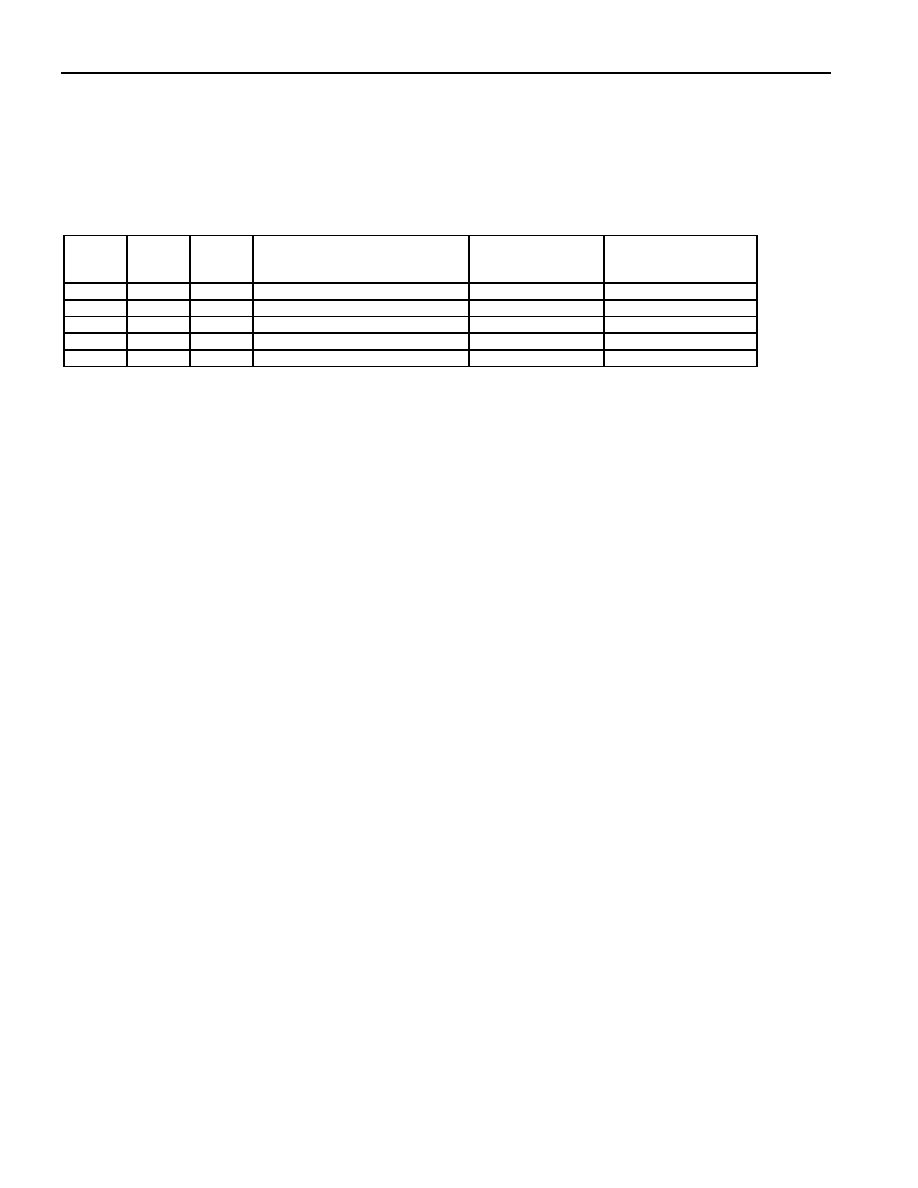- 您现在的位置:买卖IC网 > PDF目录97870 > DS80C390-FCR (MAXIM INTEGRATED PRODUCTS INC) 8-BIT, MROM, 100 MHz, MICROCONTROLLER, PQFP64 PDF资料下载
参数资料
| 型号: | DS80C390-FCR |
| 厂商: | MAXIM INTEGRATED PRODUCTS INC |
| 元件分类: | Microcontroller |
| 英文描述: | 8-BIT, MROM, 100 MHz, MICROCONTROLLER, PQFP64 |
| 封装: | LQFP-64 |
| 文件页数: | 33/54页 |
| 文件大小: | 2030K |
| 代理商: | DS80C390-FCR |
第1页第2页第3页第4页第5页第6页第7页第8页第9页第10页第11页第12页第13页第14页第15页第16页第17页第18页第19页第20页第21页第22页第23页第24页第25页第26页第27页第28页第29页第30页第31页第32页当前第33页第34页第35页第36页第37页第38页第39页第40页第41页第42页第43页第44页第45页第46页第47页第48页第49页第50页第51页第52页第53页第54页

DS80C390 Dual CAN High-Speed Microprocessor
39 of 54
the microcontroller can never be operated faster than 40MHz. This means that the maximum crystal oscillator or
external clock source is 10MHz when using the 4X setting, and 20MHz when using the 2X setting.
The primary advantage of the clock multiplier is that it allows the microcontroller to use slower crystals to achieve
the same performance level. This reduces EMI and cost, as slower crystals are generally more available and thus
less expensive.
Table 11. System Clock Configuration
CD1
CD0
4X/
2X
FUNCTION
CLOCKS PER
MACHINE CYCLE
MAX EXTERNAL
FREQUENCY
(MHz)
0
Frequency Multiplier (2X)
2
20
0
1
Frequency Multiplier (4X)
1
10
0
1
N/A
Reserved
—
1
0
N/A
Divide-by-4 (Default)
4
40
1
N/A
Power Management Mode
1024
40
The system clock and machine cycle rate changes one machine cycle after the instruction changing the control
bits. Note that the change affects all aspects of system operation, including timers and baud rates. The use of the
switchback feature, described later, can eliminate many of the problems associated with the PMM.
Changing the System Clock/Machine Cycle Clock Frequency
The microcontroller incorporates a special locking sequence to ensure “glitch-free” switching of the internal clock
signals. All changes to the CD1, CD0 bits must pass through the 10 (divide-by-4) state. For example, to change
from 00 (frequency multiplier) to 11 (PMM), the software must change the bits in the following sequence: 00 ≥ 10 ≥
11. Attempts to switch between invalid states will fail, leaving the CD1, CD0 bits unchanged.
The following sequence must be followed when switching to the frequency multiplier as the internal time source.
This sequence can only be performed when the device is in divide-by-4 operation. The steps must be followed in
this order, although it is possible to have other instructions between them. Any deviation from this order will cause
the CD1, CD0 bits to remain unchanged. Switching from frequency multiplier to non-multiplier mode requires no
steps other than the changing of the CD1, CD0 bits.
1) Ensure that the CD1, CD0 bits are set to 10, and the RGMD (EXIF.2) bit = 0.
2) Clear the CTM (Crystal Multiplier Enable) bit.
3) Set the 4X/2X bit to the appropriate state.
4) Set the CTM (crystal multiplier enable) bit.
5) Poll the CKRDY bit (EXIF.4), waiting until it is set to 1. This will take approximately 65,536 cycles of the
external crystal or clock source.
6) Set CD1, CD0 to 00. The frequency multiplier is engaged on the machine cycle following the write to these bits.
OSCILLATOR-FAIL DETECT
The microprocessor contains a safety mechanism called an on-chip oscillator-fail-detect circuit. When enabled, this
circuit causes the processor to be held in reset if the oscillator frequency falls below 40kHz. In operation, this circuit
complements the watchdog timer. Normally, the watchdog timer is initialized so that it times out and causes a
processor reset in the event that the processor loses control. In the event of a crystal or external oscillator failure,
however, the watchdog timer does not function and there is the potential for the processor to fail in an uncontrolled
state. The use of the oscillator-fail-detect circuit forces the processor to a known state (i.e., reset) even if the
oscillator stops.
The oscillator-fail-detect circuitry is enabled when software sets the enable bit OFDE (PCON.4) to 1. Please note
that software must use a timed-access procedure (described later) to write this bit. The OFDF (PCON.5) bit also
sets to 1 when the circuitry detects an oscillator failure, and the processor is forced into a reset state. This bit can
only be cleared to 0 by a power-fail reset or by software. The oscillator-fail-detect circuitry is not activated when the
oscillator is stopped due to the processor entering stop mode.
相关PDF资料 |
PDF描述 |
|---|---|
| DS80C390-QCR | 8-BIT, MROM, 100 MHz, MICROCONTROLLER, PQCC68 |
| DS80C390-QNR | 8-BIT, 40 MHz, MICROCONTROLLER, PQCC68 |
| DS80C390-FNR | 8-BIT, 40 MHz, MICROCONTROLLER, PQFP64 |
| DS80CH11 | 8-BIT, MICROCONTROLLER, PQFP128 |
| DS83C530-ENL | 8-BIT, OTPROM, 33 MHz, MICROCONTROLLER, PQFP52 |
相关代理商/技术参数 |
参数描述 |
|---|---|
| DS80C390-FCR+ | 功能描述:8位微控制器 -MCU Dual CAN High-Speed RoHS:否 制造商:Silicon Labs 核心:8051 处理器系列:C8051F39x 数据总线宽度:8 bit 最大时钟频率:50 MHz 程序存储器大小:16 KB 数据 RAM 大小:1 KB 片上 ADC:Yes 工作电源电压:1.8 V to 3.6 V 工作温度范围:- 40 C to + 105 C 封装 / 箱体:QFN-20 安装风格:SMD/SMT |
| DS80C390-FNR | 功能描述:8位微控制器 -MCU Dual CAN High-Speed RoHS:否 制造商:Silicon Labs 核心:8051 处理器系列:C8051F39x 数据总线宽度:8 bit 最大时钟频率:50 MHz 程序存储器大小:16 KB 数据 RAM 大小:1 KB 片上 ADC:Yes 工作电源电压:1.8 V to 3.6 V 工作温度范围:- 40 C to + 105 C 封装 / 箱体:QFN-20 安装风格:SMD/SMT |
| DS80C390-FNR+ | 功能描述:8位微控制器 -MCU Dual CAN High-Speed RoHS:否 制造商:Silicon Labs 核心:8051 处理器系列:C8051F39x 数据总线宽度:8 bit 最大时钟频率:50 MHz 程序存储器大小:16 KB 数据 RAM 大小:1 KB 片上 ADC:Yes 工作电源电压:1.8 V to 3.6 V 工作温度范围:- 40 C to + 105 C 封装 / 箱体:QFN-20 安装风格:SMD/SMT |
| DS80C390-QCR | 功能描述:8位微控制器 -MCU Dual CAN High-Speed RoHS:否 制造商:Silicon Labs 核心:8051 处理器系列:C8051F39x 数据总线宽度:8 bit 最大时钟频率:50 MHz 程序存储器大小:16 KB 数据 RAM 大小:1 KB 片上 ADC:Yes 工作电源电压:1.8 V to 3.6 V 工作温度范围:- 40 C to + 105 C 封装 / 箱体:QFN-20 安装风格:SMD/SMT |
| DS80C390-QCR+ | 功能描述:8位微控制器 -MCU Dual CAN High-Speed RoHS:否 制造商:Silicon Labs 核心:8051 处理器系列:C8051F39x 数据总线宽度:8 bit 最大时钟频率:50 MHz 程序存储器大小:16 KB 数据 RAM 大小:1 KB 片上 ADC:Yes 工作电源电压:1.8 V to 3.6 V 工作温度范围:- 40 C to + 105 C 封装 / 箱体:QFN-20 安装风格:SMD/SMT |
发布紧急采购,3分钟左右您将得到回复。